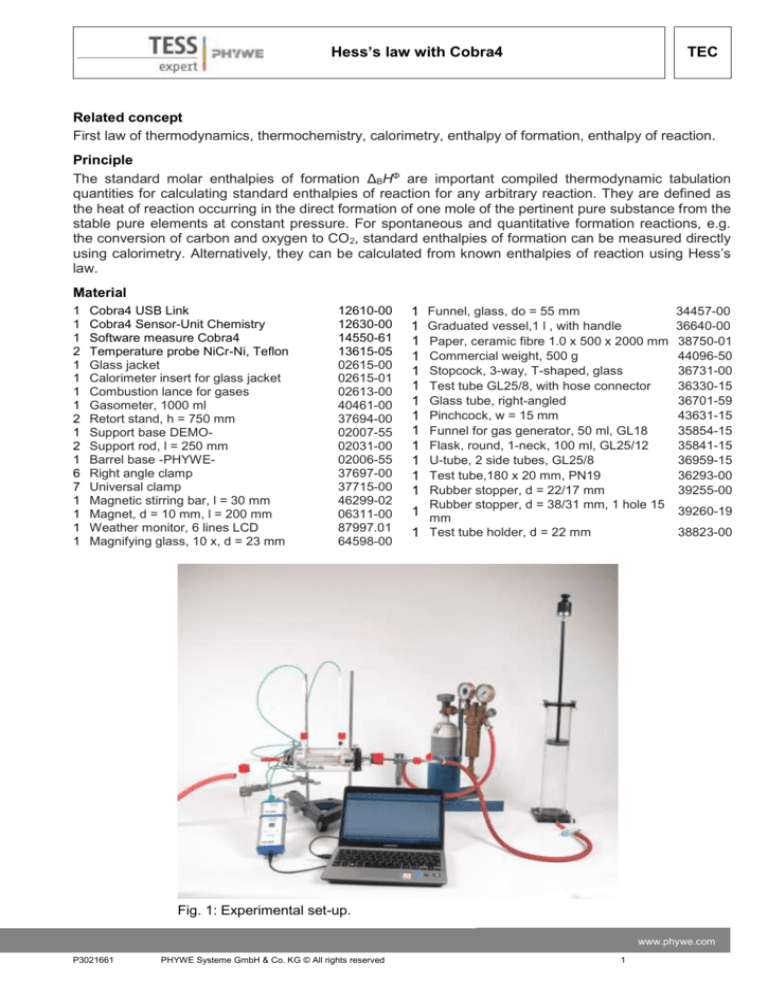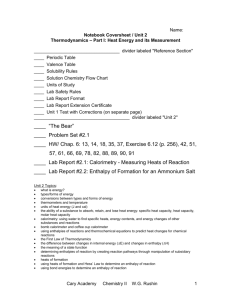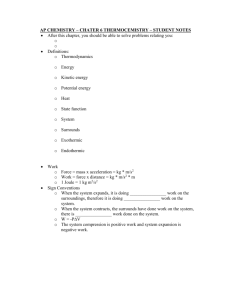
Hess’s law with Cobra4
TEC
Related concept
First law of thermodynamics, thermochemistry, calorimetry, enthalpy of formation, enthalpy of reaction.
Principle
The standard molar enthalpies of formation ΔBHΦ are important compiled thermodynamic tabulation
quantities for calculating standard enthalpies of reaction for any arbitrary reaction. They are defined as
the heat of reaction occurring in the direct formation of one mole of the pertinent pure substance from the
stable pure elements at constant pressure. For spontaneous and quantitative formation reactions, e.g.
the conversion of carbon and oxygen to CO2, standard enthalpies of formation can be measured directly
using calorimetry. Alternatively, they can be calculated from known enthalpies of reaction using Hess’s
law.
Material
1
1
1
2
1
1
1
1
2
1
2
1
6
7
1
1
1
1
Cobra4 USB Link
Cobra4 Sensor-Unit Chemistry
Software measure Cobra4
Temperature probe NiCr-Ni, Teflon
Glass jacket
Calorimeter insert for glass jacket
Combustion lance for gases
Gasometer, 1000 ml
Retort stand, h = 750 mm
Support base DEMOSupport rod, l = 250 mm
Barrel base -PHYWERight angle clamp
Universal clamp
Magnetic stirring bar, l = 30 mm
Magnet, d = 10 mm, l = 200 mm
Weather monitor, 6 lines LCD
Magnifying glass, 10 x, d = 23 mm
12610-00
12630-00
14550-61
13615-05
02615-00
02615-01
02613-00
40461-00
37694-00
02007-55
02031-00
02006-55
37697-00
37715-00
46299-02
06311-00
87997.01
64598-00
1
1
1
1
1
1
1
1
1
1
1
1
1
Funnel, glass, do = 55 mm
Graduated vessel,1 l , with handle
Paper, ceramic fibre 1.0 x 500 x 2000 mm
Commercial weight, 500 g
Stopcock, 3-way, T-shaped, glass
Test tube GL25/8, with hose connector
Glass tube, right-angled
Pinchcock, w = 15 mm
Funnel for gas generator, 50 ml, GL18
Flask, round, 1-neck, 100 ml, GL25/12
U-tube, 2 side tubes, GL25/8
Test tube,180 x 20 mm, PN19
Rubber stopper, d = 22/17 mm
Rubber stopper, d = 38/31 mm, 1 hole 15
1 mm
1 Test tube holder, d = 22 mm
34457-00
36640-00
38750-01
44096-50
36731-00
36330-15
36701-59
43631-15
35854-15
35841-15
36959-15
36293-00
39255-00
39260-19
38823-00
Fig. 1: Experimental set-up.
www.phywe.com
P3021661
PHYWE Systeme GmbH & Co. KG © All rights reserved
1
Hess’s law with Cobra4
TEC
1 Teclu burner, natural gas
1 Safety gas tubing
2
1
1
1
1
1
4
1
1
1
1
Hose clip, d = 12… 20 mm
Lighter for natural / liquified gases
Steel cylinder oxygen, 2 l, filled
Reducing valve for oxygen
Wrench for steel cylinders
Table stand for 2 l steel cylinders
Hose clip, d = 8…12 mm
Set balance Sartoruius CPA 623S and
software, 230 V, 620 g / 0,001g
Mortar with pestle,150 ml, porcelain
Scissors, straight, blunt, l = 140 mm
Tweezers, straight, blunt, l = 200 mm
32171-05
39281-10
40995-00
38874.00
41778-00
33482-00
40322-00
41774-00
40996-01
49224-88
32604-00
64625-00
40955-00
1
5
1
1
1
1
1
1
1
1
Water jet pump
Rubber tubing, di = 6 mm
Protective glasses, green glass
Quartz glass wool, 10 g
Charcoal, small pieces, 300 g
Formic acid 98-100%, 250 ml
Sulphuric acid, 95-98%, 500 ml
Sodium hydroxide, flakes, 500 g
Glycerol, 250 ml
Water, distilled, 5 l
Additional equipment
PC with USB interface, Windows XP or
1
higher
02728-00
39282-00
39317-00
31773-03
30088-30
30021-25
30219-50
30157-50
30084-25
31246-81
-
Safety instructions
When handling chemicals, you should wear suitable protective gloves, safety goggles, and suitable
clothing. Please refer to the appendix for detailed safety instructions.
Tasks
Determine the enthalpies of reaction for the combustion of
1. carbon and
2. carbon monoxide calometrically.
Use the experimentally determined enthalpies and Hess’s law to calculate the enthalpies of formation of
CO and CO2.
Set-up and preparation
Set up the experiment as shown in Fig. 1.
Fit the calorimeter insert into the glass jacket as described in the instruction manual.
Fill the graduated vessel with approximately 500 g of water and determine the mass of it on the balance (= m1).
Carefully pour the water into the glass jacket through one of the vertical tubular sleeves (using a
funnel) and weigh the vessel again (= m2). Calculate the mass of the water (m(H2O) = m2 - m1).
Immerse the temperature probes through the verticular tubular sleeves into the water.
Put a magnetic stirrer bar into the glass jacket.
Prepare and connect the bubble counter as follows: Fill a little water into the test tube with hose
connector, fit the right-angled tube on and connect it to the outlet of the calorimeter. Connect the
hose connector to the water jet pump.
Fill the gasometer with 300 to 400 ml of some flammable gas (natural gas, propane or a similar gas
which is used to produce a very small pilot flame) and connect it to the combustion lance via a rubber tube.
Connect the steel cylinder with oxygen to the combustion lance and secure all hose connections
with hose clips.
Connect the Cobra4 Sensor-Unit Chemistry to the Cobra4 USB-Link.
Connect the temperature probes to the T1 and T2 inlets of the Cobra4 Sensor-Unit Chemistry.
2
PHYWE Systeme GmbH & Co. KG © All rights reserved
P3021661
Hess’s law with Cobra4
-
1.
-
-
-
-
-
-
-
-
-
-
-
-
TEC
Start the PC and connect the Cobra4 USB-Link with the computer via a USB cable.
Call up the “Measure” programme.
Boot the experiment “Hess’s law with Cobra4” (experiment > open experiment). The measurement
parameters for this experiment are loaded now.
Burning of carbon
Since it is not possible to burn the pure forms of carbon, i.e. graphite and diamond, in a glass jacket
calorimeter because of the high activation energy levels involved, very strongly heated and completely degassed charcoal is to be prepared and used.
The heat value of this charcoal is only negligibly different from that of graphite (32682 kJ/kg compared with 32738 kJ/kg).
It is prepared as follows: Use a mortar and pestle to slightly crush a solid piece of charcoal to give
some pieces of between 0.4 and 0.7 g in size. Place these pieces in a test tube and heat them
strongly with the Teclu burner until all humidity, all tar residues and all residual gases have been
driven off. Allow it to cool in a closed vessel.
Accurately weigh one of the pre-treated pieces of carbon and place it in the combustion chamber on
a strip of ceramic paper.
Turn on the water jet pump and adjust it so that a moderate flow of air is drawn through the calorimeter (use the pinchcock on the tube between the pump and the bubble counter for this). The current
of air ensures that all of the hot gas generated is drawn through the calorimeter.
Start the measurement with
Wear dark protective glasses during the subsequent combustion of carbon in a flow of oxygen to
avoid being dazzled.
Place a weight of approximately 500 g on the plunger of the gasometer to achieve a sufficient speed
of the gas outflow.
Open the precision control valve of the combustion lance, ignite the outflowing gas, and adjust the
flame to a length of 1 to 2 cm.
Supply oxygen, adjust the length to approximately 0.5 cm, and then move the barrel base to quickly
insert this pilot flame into the glass jacket calorimeter so that the charcoal ignites.
Close the precision control valve on the gasometer.
The charcoal burns in the flow of oxygen with an extremely bright flame to form carbon dioxide.
Stir the water in the calorimeter during combustion with a magnet in order to achieve a maximum
transfer of the reaction heat to the liquid.
When combustion is complete, shut off the air flow and the oxygen supply, but continue mixing until
thermal equilibrium has re-established
Stop the measurement by pressing .
Send all data to “measure” (see Fig. 2).
Fig. 2: Window which appears after the measurement has been stopped.
-
Save the measurement (File> Save measurement as…).
www.phywe.com
P3021661
PHYWE Systeme GmbH & Co. KG © All rights reserved
3
TEC
-
Hess’s law with Cobra4
Fig. 3 shows the graph as it is presented by the programme when the measurement is stopping.
Fig. 3: Change of temperature while burning of coal.
2.
-
Burning of carbon monoxide
The experimental set-up is analogous to that of the first experiment.
The carbon monoxide (Caution: toxic!) is prepared by dehydrating formic acid with concentrated sulphuric acid. To do this, prepare the set-up shown in Fig. 4 under an extractor hood.
Fig.4: Experimental set-up for the preparation of CO.
-
-
4
Drop formic acid from the graduated funnel into the round flask containing sulphuric acid.
Clean and dry the carbon monoxide that evolves with sodium hydroxide flakes held in a U-tube between two balls of quartz glass.
Fill the gasometer with 1000 ml of carbon monoxide and again connect it to the combustion lance,
PHYWE Systeme GmbH & Co. KG © All rights reserved
P3021661
Hess’s law with Cobra4
-
-
-
-
-
TEC
which is furthermore connected to the oxygen cylinder.
Adjust the airflow with the water jet pump.
Subsequently, adjust a weak flow of carbon monoxide and ignite the gas at the tip of the combustion
lance.
Set the flame length to approximately 2 cm and add oxygen in order to guarantee complete combustion.
Start the measurement with
Wait until the sinking piston of the gasometer touches a certain mark on the scale (e.g. 900 ml) and
then move the lance to a position deep inside the combustion chamber of the calorimeter by moving
the barrel base.
Continuously but gently stir the water in the calorimeter, combust exactly 500 ml of carbon monoxide, then turn off the air flow and the oxygen supply.
Wait until thermal equilibrium has established.
Stop the measurement by pressing .
Send all data to “measure” (see Fig. 2).
Save the measurement (File> Save measurement as…).
Measure the room temperature T and the atmospheric pressure p.
Theory and evaluation
Molar enthalpies of reaction ΔRH characterise the heat balance of substance transformations. They are
defined as the heat of reaction QP = Δh occurring per mole formula conversion Δξ at constant pressure p
and constant temperature T.
For spontaneous and quantitative conversions, the molar enthalpies of reaction can be determined directly using calorimetry. Otherwise, they can also be calculated using Hess’s law of constant heat summation (the additivity of reaction enthalpies). The molar formation enthalpy ΔBH corresponds to the molar
enthalpy of reaction in the direct formation of 1 mole of the respective compound from the elements in
stable modification (for which the enthalpy of formation is zero by definition). The formation enthalpies of
most substances at p = 1013 hPa and T = 298 K are listed in tables. Therefore, the standard enthalpy of
reaction ΔBHΦ of any arbitrary reaction is equal to the stoichiometric sum of the standard enthalpies of
formation ΔBHΦ of the participating educts and products, whereby the original substances are entered
with negative stoichiometric values νi.
With regard to the reactions
The following is obtained from equation (2):
www.phywe.com
P3021661
PHYWE Systeme GmbH & Co. KG © All rights reserved
5
TEC
Hess’s law with Cobra4
and
The enthalpy of formation of CO2 is hence directly equal to the enthalpy of reaction ΔRH1 arising from
the complete combustion of 1 mole of carbon. The enthalpy of formation of CO is calculated adding reactions 1 and 2:
The molar enthalpies ΔRH1 and ΔRH2 can be calculated from the experimental data using equation (1).
The change in enthalpy of the reacting system Δh corresponds to the negative heat balance Qcal of the
calorimeter which can be derived from equation (3):
where
m(H2O) Mass of water in the calorimeter
c(H2O) Specific heat capacity of water (4.1868 J · g-1 · K-1)
Ccal Mean heat capacity of the glass jacket calorimeter used (410 J · K-1)
ΔT Temperature difference in K
As a result of the expression
the amount of formula conversions Δξ is equal to the converted material Δνi of carbon (reaction 1) or
carbon monoxide (reaction 2) which can be calculated using
6
PHYWE Systeme GmbH & Co. KG © All rights reserved
P3021661
Hess’s law with Cobra4
TEC
where
m(C) Mass of carbon used
M(C) Molar mass of carbon (12.01 g · mol-1)
It can also be derived from the general equation of state for ideal gases (ideal gas law) if the room temperature T, the atmospheric pressure p and the volume of carbon monoxide combusted V are known.
Universal gas constant (8.31441 Nm · K-1 · mol-1)
R
Data and results
The combustion of 0.4627 g of carbon (n = 38.53 mmol) increased the temperature of the 500 g water in
the filled glass jacket calorimeter by ΔT = 2.2 K.
The oxidation of 500 ml CO at T = 298.05 K and p = 986 hPa (n = 19.89 mmol) caused a temperature
increase of ΔT = 0.6 K.
The molar enthalpies of reaction calculated from these values are:
ΔRH1 = ΔBH(CO2) = -389.9 kJ · mol-1,
ΔRH2 = -276.8 kJ · mol-1 and
ΔRH3 = ΔBH(CO) = -113.1 kJ · mol-1.
Lit. values: ΔBH(CO2) = -393.5 kJ · mol-1,
ΔBH(CO) = -110.5 kJ · mol-1.
Disposal
The acids and bases have to neutralized and diluted before one can rinse them into the drain.
Appendix
Hazard symbol, signal word
Hazard statements
Precautionary statements
H314: Causes severe skin
burns and eye damage.
H290: May be corrosive to
metals.
P280: Wear protective
gloves/protective clothing/eye protection/face
protection.
P301 + P330 + P331: F
SWALLOWED: Rinse
mouth. Do NOT induce
Sodium hydroxide
www.phywe.com
P3021661
PHYWE Systeme GmbH & Co. KG © All rights reserved
7
Hess’s law with Cobra4
TEC
vomiting.
Formic acid
H226: Flammable liquid
and vapour
H314: Causes severe skin
burns and eye damage
P260: Do not breathe
dust/fume/gas/mist/vapo
urs/spray
P280: Wear protective
gloves/protective clothing/eye protection/face
protection
P301 + 330 + 331: IF
SWALLOWED: Rinse
mouth. Do NOT induce
vomiting
P305 + 351 +338: IF IN
EYES: Rinse cautiously
with water for several
minutes. Remove contact lenses if present and
easy to do. continue rinsing
P309: IF exposed or you
feel unwell:
P310: Immediately call a
POISON CENTER or
doctor/physician
H314: Causes severe skin
burns and eye damage.
P280: Wear protective
gloves/protective clothing/eye protection/face
protection.
P301 + 330 +331: IF
SWALLOWED: Rinse
mouth. Do NOT induce
vomiting.
P309 + 310: IF exposed
or you feel unwell: Immediately call a POISON
CENTER or doctor/physician.
P305 + 351 + 338: IF IN
EYES: Rinse cautiously
with water for several
minutes. Remove contact lenses if present and
easy to do. Continue
rinsing.
Danger
Sulphuric acid 95 _ 98 %
Warning
8
PHYWE Systeme GmbH & Co. KG © All rights reserved
P3021661








